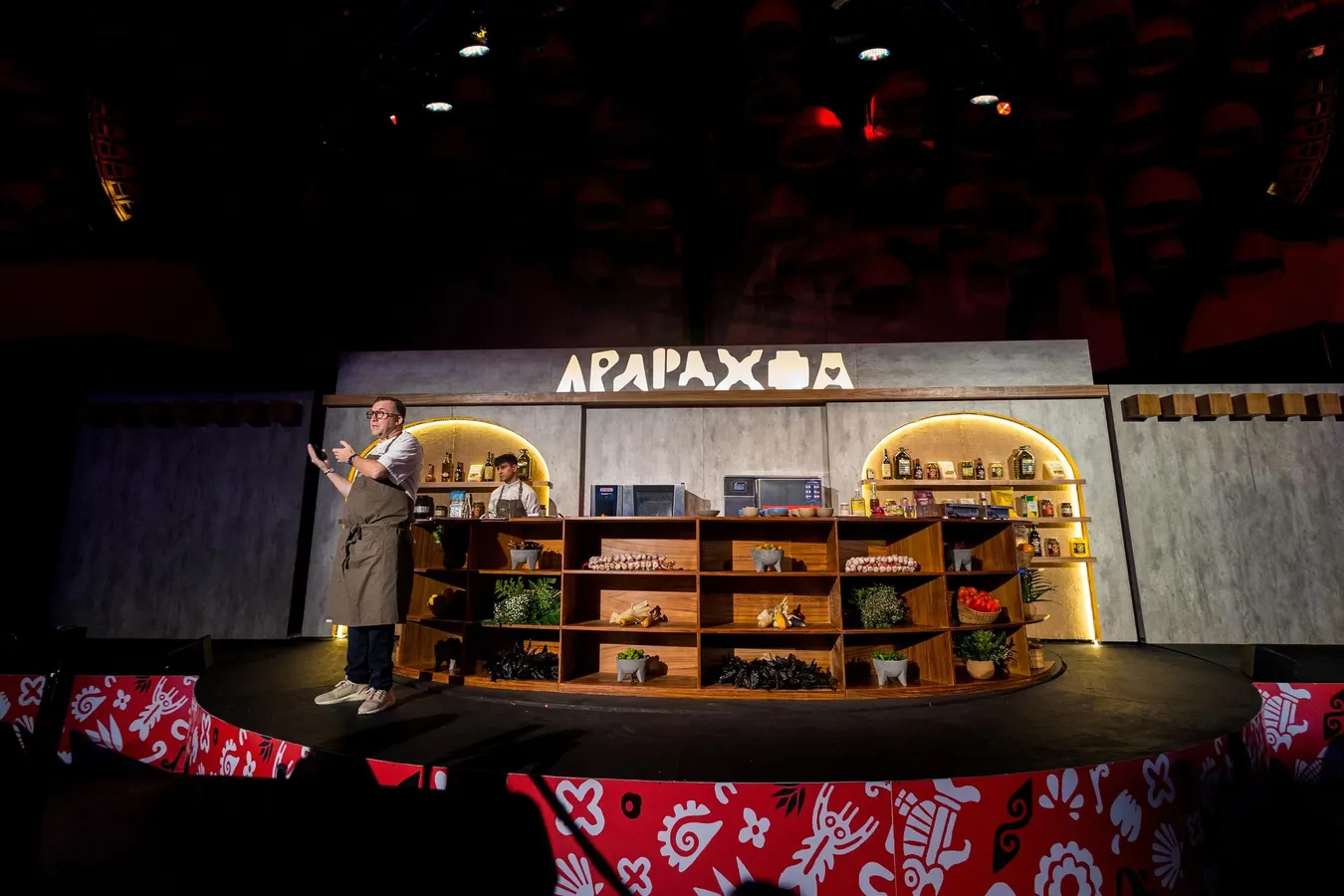Copyright forbes

Mexican Chef Chele Gonzalez discussing the impact of Mexico's galleon trade with the Philippines and how Asian spices influenced Mexican cuisine Photo, courtesy Apapaxoa Festical Gastrocultural According to Mexican chef Lula Martin del Campo, there is no such thing as Mexican cuisine. That statement may be startling to generations of Americans raised on Taco Bell-style fast food and the ubiquitous guacamole or fajitas that are de rigueur at your neighborhood Mexican restaurant. It underscores, however, the incredible diversity and regional character of Mexican cooking that I observed during my recent visit to the Apapaxoa Festival Gastrocultural—organized by Gruppo Xcaret in Xcaret, Riviera Maya, Quintana Roo (Yucatan). The festival is one of the most important culinary events in Mexico. It offers a fascinating introduction to the scope and sophistication of contemporary Mexican gastronomy. Ms. del Campo, the owner and head chef of Marea and Cascabel, two of Mexico City’s leading restaurants, went on to add that each region of Mexico has its own distinctive cuisine, typically fashioned from local ingredients and shaped by its history and culinary traditions. Chef Lula Martin del Campo discussing Mexico's culinary heritage. Walter Tot Photography Carlos Gaytan, Mexico’s first chef to earn a Michelin Star for Ha’ at the Hotel Xcaret Mexico and chef-owner of Tzuco on Chicago’s Gold Coast, among other restaurants, put it another way. The typical Mexican entrée consists of a protein, corn, and beans, he noted, but all three of those ingredients vary dramatically among the different regions of Mexico. What Americans associate with “Mexican food”, he added, is actually the regional cuisine of Sonora and Chihuahua, and, to a lesser extent, Coahuila, Nuevo Leon, and Tamaulipas, reinterpreted for an American palate. All five Mexican states border the US. Other chefs noted that the taco, arguably the most recognizable and quintessential Mexican dish, has more than 400 regional variations across Mexico, with each region having its characteristic taco expressions. Gaytan also points out that Mexican cuisine has always been a “fusion cuisine”, long before that concept became fashionable in culinary circles. Animal protein in pre-Hispanic Mexico consisted primarily of wild game and a few domesticated fowl, he noted, while corn, peppers, and beans were ubiquitous. Most of the sources of domesticated animal protein were introduced by the Spanish, he notes, and added to the staple diet of Mexico’s indigenous population. Laura Noguera, one of Mexico’s experts on Mexican gastronomy and agave spirits, refers to Mexico’s pre-Hispanic diet as the “Meso-American diet,” likening it to the Mexican equivalent of the popular Mediterranean diet. She notes that the Spanish historian Bernardino de Sahagun, writing in the 16th century in what is now known as the Florentine Codex, described Mexico as “a garden populated by all kinds of fruit-bearing trees and all kinds of herbs, where there are springs and rivers of various kinds. It is full of birds, animals, and fish of all kinds”, adding that “due to its natural wealth, the diet of its inhabitants was very varied and healthy.” That initial fusion of the Meso-American diet with Spanish cuisine was supplemented by Asian spices, a byproduct of Spain’s lucrative galleon trade with the Philippines, and later by French and, eventually, Italian influences. The result is a cuisine that transcends pre-Hispanic Mexico, incorporating indigenous Mexican foods with Asian and European ingredients and cooking techniques. Fresh seafood is a staple of Mexican cuisine especially along the costal regions Walter Tot Photography Nowhere is this fusion tradition more evident than in Mexico’s mole cuisine. Mole, Mexico’s ubiquitous sauce, has a pre-Hispanic origin. Contemporary mole, however, incorporates Mexico’s indigenous food, Asian spices, and European staples to produce a dizzying range of sauces. According to chef-scholar Ricardo Muñoz Zurita, writing in the Larousse Encyclopedia, there are at least 90 different styles of mole across Mexico. Each region has its own styles and mole traditions. But like Italian pasta sauces, every grandmother has her own special variation. The actual count of moles is likely in the hundreds, if not the thousands. The Apapaxoa Festival Gastrocultural brings together some of Mexico’s leading chefs for a week of seminars, panel discussions, workshops, and, of course, fabulous dinners that showcase the best of contemporary Mexican cuisine. The festival is organized by the Hotel Xcaret Hotel group (Hotel Xcaret Arte, Hotel Xcaret Mexico, and La Casa de la Playa), which is one of Mexico’s leading hospitality companies. The Xcaret Hotel Group (Hoteles Xcaret) is the hospitality arm of Grupo Xcaret, a Mexican company renowned for its eco-cultural parks and commitment to sustainable tourism in the Riviera Maya. Grupo Xcaret’s story began when architect Miguel Quintana Pali discovered cenotes and underground rivers on land he bought in the 1980s. With partners Óscar, Marcos, and Carlos Constandse, he opened Xcaret Park in December 1990, laying the groundwork for the brand as it exists today. The group launched Hotel Xcaret México in December 2017, introducing its signature “All-Fun Inclusive” model—unlimited access and transportation to the company’s parks and tours. In 2021, the portfolio expanded with the addition of the 900 suite, an adults-only property, Hotel Xcaret Arte, and, later, La Casa de la Playa, a boutique 63-suite oceanfront property. The three hotels host 35 different boutique restaurants, including several that boast Michelin Stars. Many of the restaurants have appeared on Latin America’s 50 Best Restaurants and the World’s 50 Best Restaurants lists, as well as earning numerous Best Chef awards and Michelin Guide recommendations. Mexican chefs from Quintana Roo receiving their 2025 Michelin Star during the Apapaxoa Gastrocultural Festival Walter Tot Photography Not surprisingly, many of the featured dinners feature pairings with Tequila and Mezcal. Several major Tequila companies attended the Festival, most notably Don Julio and Patron, two of Mexico’s leading Tequila brands. The Festival’s organizers have indicated that, in the future, they plan to expand the presence of Tequila and Mezcal brands at next year’s event. La Casa de La Playa also hosts La Chocolateria, run by Chef Mauricio Montiel. Available 24/7 and part of the hotel’s all-inclusive package, the Chocolateria has also won numerous awards for its chocolate creations. All-inclusive resorts are not new. The concept was pioneered by hospitality companies like Club Med decades ago; however, the idea of luxury all-inclusive resorts is relatively new. According to Akis Neocleous, the Xcaret Group’s Chief Hotels Officer, Xcaret was among the first to pioneer a luxury “All Fun Inclusive” concept in Mexico and helped popularize it, especially along the Riviera Maya in Quintana Roo. The Festival is now in its second year and is open to any hotel guest. You can also register separately for just the festival, even if you are not a hotel guest. There are various ticketing options, ranging from day passes to a whole week’s participation or individual dinners. Although much of the hotel’s staff is bilingual, the proceedings themselves were mostly held in Spanish. According to Neocleous, however, next year’s Festival will offer simultaneous translations in English, significantly expanding the pool of potential visitors. Tickets typically go on sale in early summer, but you can assure yourself a spot by booking a stay at any one of the three hotels at any time. Xcaret Group Chief Hotels Officer Akis Neocleous with Head Chef Andoni Luis Aduriz and his culinary team at the Xal restaurant in La Casa de la Playa Photo, courtesy Apapaxoa Festical Gastrocultural The Festival also highlights the crucial role that Mexican gastronomy plays in the economic development of Mexico’s rural communities, particularly in many indigenous farming communities that have been socioeconomically disadvantaged. Several chefs, most notably Lula Martin del Campo and the three Rio Brothers who oversee the Centil and Lumbre restaurants at La Casa de la Playa, among others in Mexico, pointed out how they reach out to indigenous farming communities to grow heirloom varieties of corn, beans, and peppers they feature in their restaurants. This outreach is not without its challenges. Product quality, consistency, and reliable deliveries can pose challenges, especially for chefs seeking just-in-time delivery of fresh produce. The impact on indigenous farmers, however, can be dramatic and an essential vehicle of economic development. Mexican gastronomy doesn’t just taste good; it’s an important and powerful vehicle for economic transformation. Mexican gastronomy is among the most sophisticated in the world. It was the world’s first fusion cuisine, the first to integrate Asian and European ingredients and cooking techniques with the cuisine of Mexico’s indigenous people. If you think that Mexican cuisine begins and ends with tacos and guacamole, you have a whole delicious world of Mexican gastronomy waiting to be discovered. Ready to get started, the 2026 Apapaxoa Festival Gastrocultural is slated for Sept 11-16 and offers a splendid introduction to the wonders of the Mexican kitchen. More From Forbes ForbesThe World’s Top Mezcal, According To The Beverage Testing InstituteBy Joseph V MicallefForbesIs The Tequila Boom Over? Not Exactly, But It’s ComplicatedBy Joseph V Micallef ForbesThe World’s Best Tequila And Mezcal, According To The American Distilling InstituteBy Joseph V Micallef Editorial StandardsReprints & Permissions



